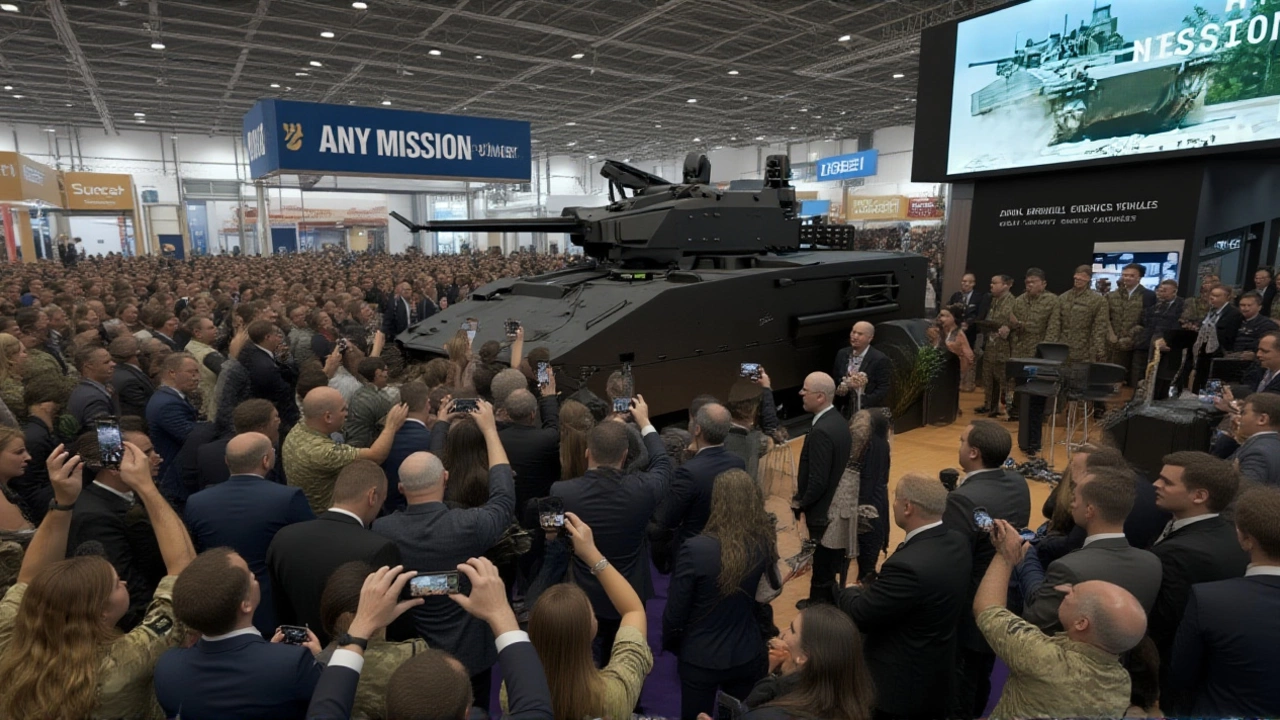UK Ajax Tanks Lack Anti-Drone Ammo Despite Ukraine Lessons, IOC Declared 8 Years Late
The British Army has declared Initial Operating Capability for its Ajax armored fighting vehicle program — but with a glaring gap: no airburst ammunition to counter the very threat that’s reshaping modern warfare. The announcement, made on November 6, 2025, came eight years after the original 2017 deadline, following a troubled development cycle marred by vibration-induced injuries, repeated delays, and now, a critical weapons shortfall. While the £5.5 billion program delivered 128 vehicles in 2025 alone, and will ultimately field 589 across six variants, the General Dynamics Land Systems–UK vehicles will lack the one round that could save crews from the relentless drone attacks seen in Ukraine.
Why the Missing Airburst Round Matters
Of the seven ammunition types developed for the 40mm Cased Telescoped Ammunition (CTA) gun by CTA International, only three are being procured: APFSDS-T for piercing armor, GPR-PD-T for general ground targets, and TP-T for training. The KE-AB — Kinetic Energy-Air Burst — was explicitly designed to explode mid-air, spraying tungsten pellets downward to shred drones, blind optics, or kill exposed infantry. CTA International called it "particularly effective against all aerial threats." Yet, it’s not on the Ajax’s shelf.
Here’s the thing: in Ukraine, drones didn’t just spy — they killed. From cheap FPV quadcopters to loitering munitions like the Lancet, Russian forces have turned armored columns into targets. A single drone can drop a grenade on a vehicle’s thin top armor. No amount of steel plating helps if you can’t shoot back at something flying at 100 mph. The British Army knows this. They’ve even begun testing "cope cages" — slat armor meant to detonate drone bombs early. But that’s a bandage. The KE-AB round? That’s the scalpel.
Eight Years Behind, and Still Not Ready
The Ajax program began in 2014 with a promise: deliver a next-gen reconnaissance platform by 2017. Instead, the first vehicles rolled out in 2025. Why? Two major suspensions of testing — first over crew hearing loss, then joint swelling from violent vibrations. Crews couldn’t fire the 40mm gun while moving. That’s not a glitch — it’s a tactical death sentence. The vehicles, weighing 38–40 metric tons, are nearly four times heavier than the Scimitar they replaced. At nearly £10 million each ($13 million), they’re among the most expensive armored vehicles in NATO’s inventory.
By November 6, 2025, the UK Ministry of Defence declared IOC. But "operational" doesn’t mean "effective." Deputy Defence Minister Luke Pollard admitted the delays, calling the vehicles ready "for deployment on NATO’s eastern flank." That’s the kicker. They’re being sent to a region where Russian drones are already hunting NATO patrols. Without airburst rounds, Ajax crews will be sitting ducks.

Jobs, Industrial Might — and Strategic Blind Spots
The MoD is right to celebrate the economic impact. The program supports over 4,100 jobs across 230+ UK companies, centered at General Dynamics’ Merthyr Tydfil plant in Wales. National Armaments Director Rupert Pearce called Ajax "transformational." Maj Gen Anna-Lee Reilly praised its digital systems and reconnaissance suite. And yes — the vehicle’s sensors, thermal imaging, and networked battlefield links are world-class.
But here’s the twist: technology without firepower is just a fancy target. Analysts at the Royal United Services Institute warn that Ajax’s heavy weight limits mobility in urban or forested terrain, and its ammunition list ignores the most common threat. The new IFV variant unveiled at DSEI 2025 — with its extended hull and Lockheed Martin uncrewed turret — looks impressive. But without airburst capability, it’s still blind to the skies.
What Comes Next? The Drone Arms Race
The British Army isn’t ignoring the problem. They’re exploring electronic jamming, drone-detection radars, and even laser countermeasures. But those systems take time — and money. Meanwhile, Ukraine’s frontline units are already modifying their own vehicles with mesh cages and smoke launchers. The U.S. is fielding the M10 Booker with a 30mm cannon that fires airburst rounds. Germany’s Puma IFV has the same. Even Poland’s Borsuk is getting airburst capability.
Ajax’s lack of this round isn’t a technical oversight — it’s a strategic misjudgment. The decision likely stems from budget pressures, schedule urgency, or a belief that "other systems" will handle the drone threat. But in modern warfare, every vehicle must be self-sufficient. You don’t wait for a drone to show up before you realize you’re unarmed.

What This Means for NATO
When Ajax units deploy to Eastern Europe, they’ll be among the first line of defense. But if they can’t engage low-flying threats, they become liabilities — not assets. Commanders will have to assign dedicated anti-air units to protect them, stretching thin resources. Allies will question the UK’s readiness. And soldiers? They’ll be the ones paying the price.
The Ajax was meant to be Britain’s answer to modern armored warfare. Instead, it’s a monument to bureaucratic delay — and a sobering reminder that speed and cost can’t replace strategic foresight.
Frequently Asked Questions
Why didn’t the British Army buy the airburst ammunition for Ajax?
The UK Ministry of Defence hasn’t publicly stated a reason, but experts believe budget constraints and schedule pressure led to prioritizing basic rounds over specialized ones. The KE-AB round was likely deemed non-essential for "immediate" needs, even though Ukraine proved its value. Procurement decisions were made before the full scope of drone threats became undeniable.
How does this affect British troops deployed on NATO’s eastern flank?
Without airburst rounds, Ajax crews will be vulnerable to drone attacks that can strike from above — a tactic routinely used by Russian forces. They’ll rely on external support or "cope cages," which only mitigate blast damage, not direct hits. This increases risk during reconnaissance missions and could force units to operate more cautiously, reducing their tactical effectiveness.
Are other NATO countries solving this problem?
Yes. The U.S. M10 Booker, Germany’s Puma IFV, and Poland’s Borsuk all include airburst-capable 30mm or 40mm cannons. Even Ukraine’s modified BMPs now carry airburst grenades. The UK is falling behind in a key area of modern armor doctrine — not because of technology, but because of procurement choices.
Can the Ajax be retrofitted with airburst ammo later?
Possibly. The 40mm CTA gun is designed to fire all seven rounds — including KE-AB — so the hardware isn’t the barrier. The issue is funding, bureaucratic approval, and timeline. Retrofitting would require new ammunition stockpiles, training, and software updates. It could take 18–24 months, meaning frontline units may remain vulnerable well into 2027.
What’s the cost of the Ajax program versus its capabilities?
At nearly £10 million per vehicle, Ajax is among the costliest armored platforms in NATO. Yet, it lacks a core defensive feature proven essential in Ukraine. Compare that to the U.S. Stryker, which costs under $5 million and can be upgraded with drone-jamming kits. The UK spent more for less combat flexibility — a troubling trade-off for a force preparing for high-intensity conflict.
Will the Ajax program be scaled back because of these issues?
Not yet. The UK government is heavily invested — politically and economically — in the program’s success. With over 4,100 jobs tied to it, cutting back is unlikely. Instead, pressure is growing to fix the ammunition gap through a separate procurement initiative, possibly under the 2026 Defense Review. But without public accountability, the same mistakes could repeat.





